BN502: Influences on Nursing Practice, Competencies, and Boundaries
VerifiedAdded on 2023/01/17
|11
|3482
|60
Essay
AI Summary
This essay delves into the historical and contemporary factors that have shaped the nursing profession, focusing on the context of New Zealand. It begins by examining Florence Nightingale's environmental theory as a key historical influence, highlighting its impact on nursing approaches and practices. The essay then explores multiculturalism as a significant contemporary factor, emphasizing the importance of cultural competence and sensitivity in providing patient-centered care in a diverse society. Furthermore, it identifies and discusses the essential competencies for registered nurses, emphasizing professional responsibility and its implementation in the workplace. The essay also addresses the crucial role of professional boundaries in maintaining safe and effective nurse-client relationships, ensuring patient trust and well-being. Finally, the essay discusses cultural safety, the Treaty of Waitangi, and Maori health, highlighting the importance of incorporating cultural considerations in nursing practice to improve health outcomes. In essence, the essay provides a comprehensive overview of the key aspects influencing and shaping the nursing profession, emphasizing the need for nurses to adhere to regulations, standards, and legislation for optimal patient care.
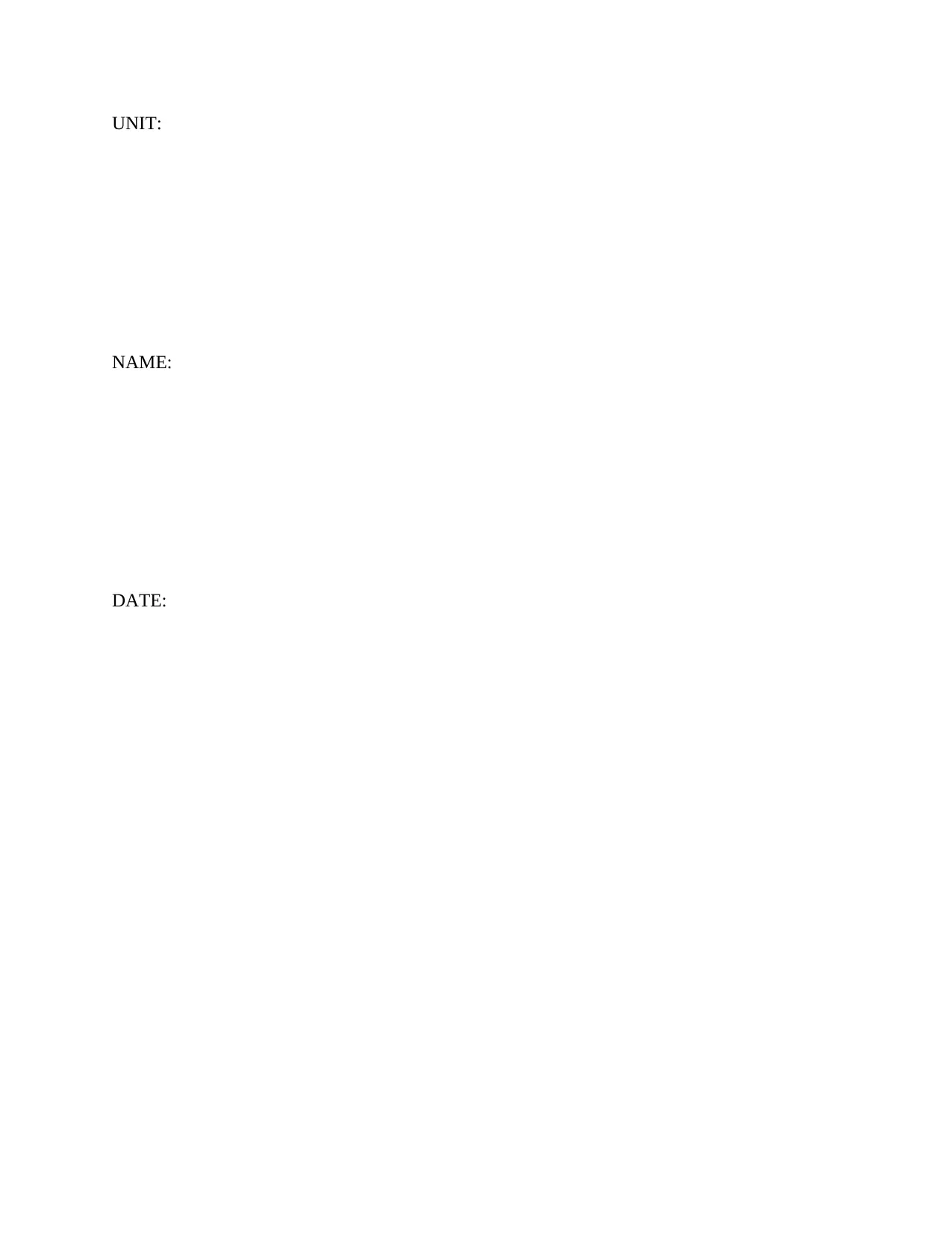
UNIT:
NAME:
DATE:
NAME:
DATE:
Paraphrase This Document
Need a fresh take? Get an instant paraphrase of this document with our AI Paraphraser
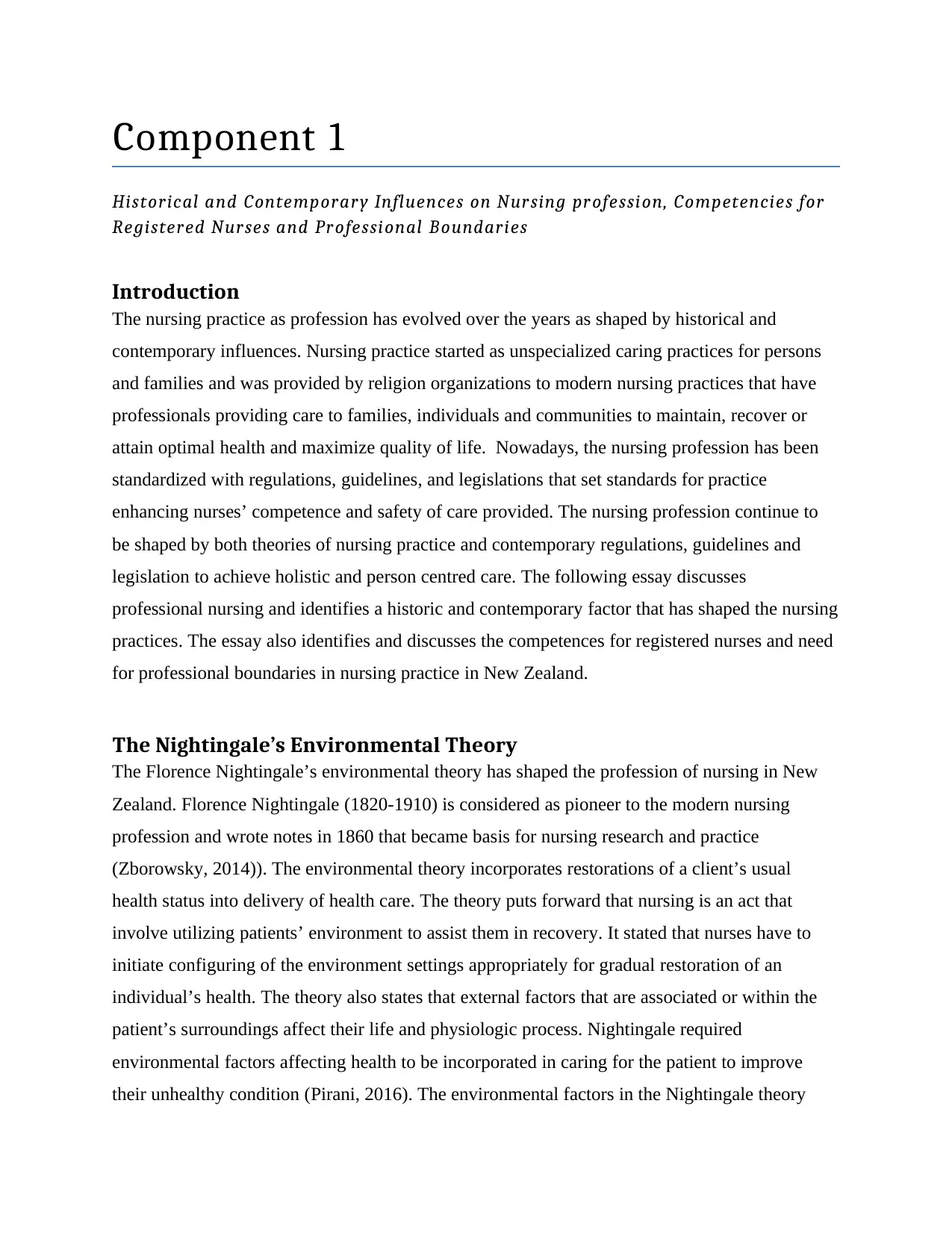
Component 1
Historical and Contemporary Influences on Nursing profession, Competencies for
Registered Nurses and Professional Boundaries
Introduction
The nursing practice as profession has evolved over the years as shaped by historical and
contemporary influences. Nursing practice started as unspecialized caring practices for persons
and families and was provided by religion organizations to modern nursing practices that have
professionals providing care to families, individuals and communities to maintain, recover or
attain optimal health and maximize quality of life. Nowadays, the nursing profession has been
standardized with regulations, guidelines, and legislations that set standards for practice
enhancing nurses’ competence and safety of care provided. The nursing profession continue to
be shaped by both theories of nursing practice and contemporary regulations, guidelines and
legislation to achieve holistic and person centred care. The following essay discusses
professional nursing and identifies a historic and contemporary factor that has shaped the nursing
practices. The essay also identifies and discusses the competences for registered nurses and need
for professional boundaries in nursing practice in New Zealand.
The Nightingale’s Environmental Theory
The Florence Nightingale’s environmental theory has shaped the profession of nursing in New
Zealand. Florence Nightingale (1820-1910) is considered as pioneer to the modern nursing
profession and wrote notes in 1860 that became basis for nursing research and practice
(Zborowsky, 2014)). The environmental theory incorporates restorations of a client’s usual
health status into delivery of health care. The theory puts forward that nursing is an act that
involve utilizing patients’ environment to assist them in recovery. It stated that nurses have to
initiate configuring of the environment settings appropriately for gradual restoration of an
individual’s health. The theory also states that external factors that are associated or within the
patient’s surroundings affect their life and physiologic process. Nightingale required
environmental factors affecting health to be incorporated in caring for the patient to improve
their unhealthy condition (Pirani, 2016). The environmental factors in the Nightingale theory
Historical and Contemporary Influences on Nursing profession, Competencies for
Registered Nurses and Professional Boundaries
Introduction
The nursing practice as profession has evolved over the years as shaped by historical and
contemporary influences. Nursing practice started as unspecialized caring practices for persons
and families and was provided by religion organizations to modern nursing practices that have
professionals providing care to families, individuals and communities to maintain, recover or
attain optimal health and maximize quality of life. Nowadays, the nursing profession has been
standardized with regulations, guidelines, and legislations that set standards for practice
enhancing nurses’ competence and safety of care provided. The nursing profession continue to
be shaped by both theories of nursing practice and contemporary regulations, guidelines and
legislation to achieve holistic and person centred care. The following essay discusses
professional nursing and identifies a historic and contemporary factor that has shaped the nursing
practices. The essay also identifies and discusses the competences for registered nurses and need
for professional boundaries in nursing practice in New Zealand.
The Nightingale’s Environmental Theory
The Florence Nightingale’s environmental theory has shaped the profession of nursing in New
Zealand. Florence Nightingale (1820-1910) is considered as pioneer to the modern nursing
profession and wrote notes in 1860 that became basis for nursing research and practice
(Zborowsky, 2014)). The environmental theory incorporates restorations of a client’s usual
health status into delivery of health care. The theory puts forward that nursing is an act that
involve utilizing patients’ environment to assist them in recovery. It stated that nurses have to
initiate configuring of the environment settings appropriately for gradual restoration of an
individual’s health. The theory also states that external factors that are associated or within the
patient’s surroundings affect their life and physiologic process. Nightingale required
environmental factors affecting health to be incorporated in caring for the patient to improve
their unhealthy condition (Pirani, 2016). The environmental factors in the Nightingale theory
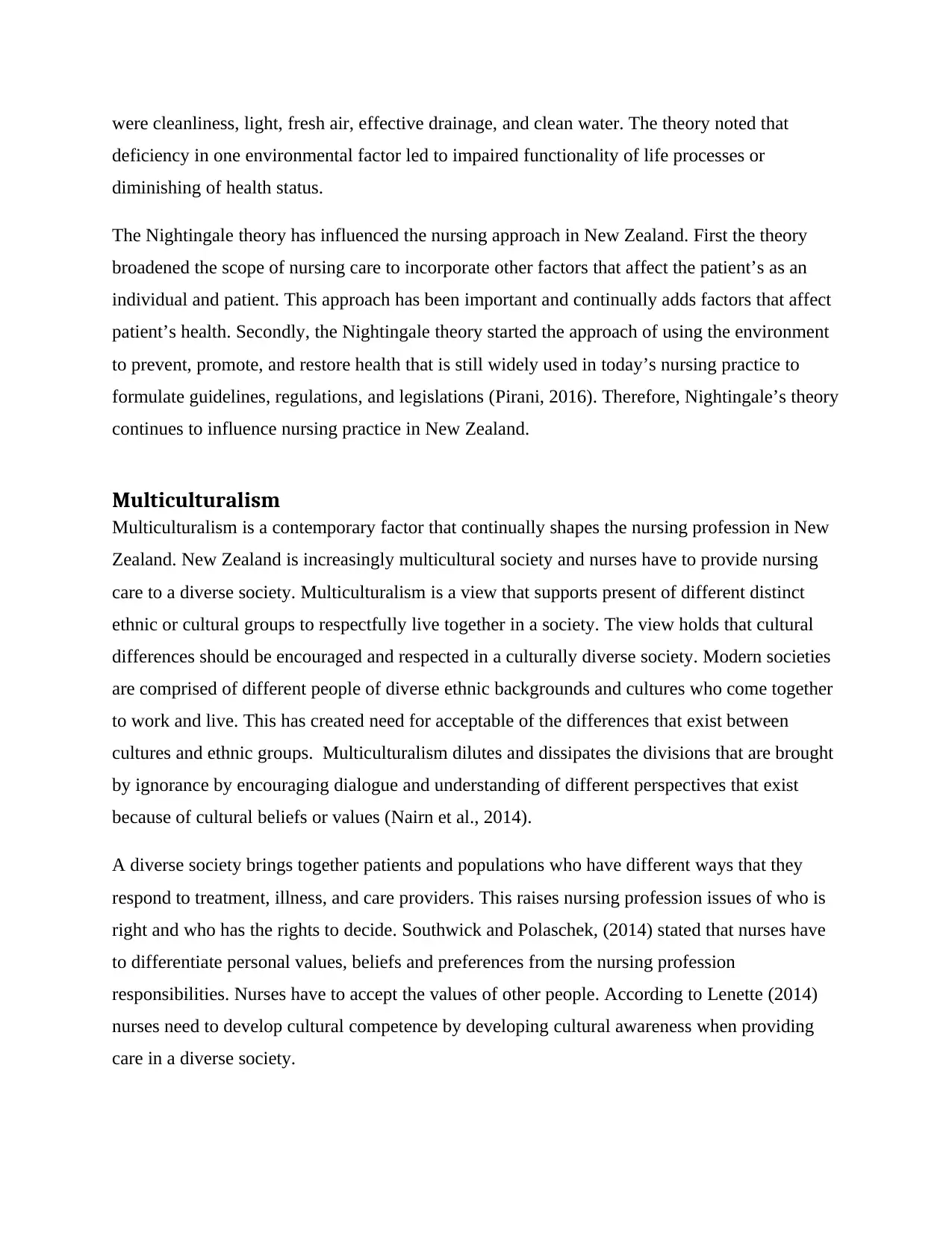
were cleanliness, light, fresh air, effective drainage, and clean water. The theory noted that
deficiency in one environmental factor led to impaired functionality of life processes or
diminishing of health status.
The Nightingale theory has influenced the nursing approach in New Zealand. First the theory
broadened the scope of nursing care to incorporate other factors that affect the patient’s as an
individual and patient. This approach has been important and continually adds factors that affect
patient’s health. Secondly, the Nightingale theory started the approach of using the environment
to prevent, promote, and restore health that is still widely used in today’s nursing practice to
formulate guidelines, regulations, and legislations (Pirani, 2016). Therefore, Nightingale’s theory
continues to influence nursing practice in New Zealand.
Multiculturalism
Multiculturalism is a contemporary factor that continually shapes the nursing profession in New
Zealand. New Zealand is increasingly multicultural society and nurses have to provide nursing
care to a diverse society. Multiculturalism is a view that supports present of different distinct
ethnic or cultural groups to respectfully live together in a society. The view holds that cultural
differences should be encouraged and respected in a culturally diverse society. Modern societies
are comprised of different people of diverse ethnic backgrounds and cultures who come together
to work and live. This has created need for acceptable of the differences that exist between
cultures and ethnic groups. Multiculturalism dilutes and dissipates the divisions that are brought
by ignorance by encouraging dialogue and understanding of different perspectives that exist
because of cultural beliefs or values (Nairn et al., 2014).
A diverse society brings together patients and populations who have different ways that they
respond to treatment, illness, and care providers. This raises nursing profession issues of who is
right and who has the rights to decide. Southwick and Polaschek, (2014) stated that nurses have
to differentiate personal values, beliefs and preferences from the nursing profession
responsibilities. Nurses have to accept the values of other people. According to Lenette (2014)
nurses need to develop cultural competence by developing cultural awareness when providing
care in a diverse society.
deficiency in one environmental factor led to impaired functionality of life processes or
diminishing of health status.
The Nightingale theory has influenced the nursing approach in New Zealand. First the theory
broadened the scope of nursing care to incorporate other factors that affect the patient’s as an
individual and patient. This approach has been important and continually adds factors that affect
patient’s health. Secondly, the Nightingale theory started the approach of using the environment
to prevent, promote, and restore health that is still widely used in today’s nursing practice to
formulate guidelines, regulations, and legislations (Pirani, 2016). Therefore, Nightingale’s theory
continues to influence nursing practice in New Zealand.
Multiculturalism
Multiculturalism is a contemporary factor that continually shapes the nursing profession in New
Zealand. New Zealand is increasingly multicultural society and nurses have to provide nursing
care to a diverse society. Multiculturalism is a view that supports present of different distinct
ethnic or cultural groups to respectfully live together in a society. The view holds that cultural
differences should be encouraged and respected in a culturally diverse society. Modern societies
are comprised of different people of diverse ethnic backgrounds and cultures who come together
to work and live. This has created need for acceptable of the differences that exist between
cultures and ethnic groups. Multiculturalism dilutes and dissipates the divisions that are brought
by ignorance by encouraging dialogue and understanding of different perspectives that exist
because of cultural beliefs or values (Nairn et al., 2014).
A diverse society brings together patients and populations who have different ways that they
respond to treatment, illness, and care providers. This raises nursing profession issues of who is
right and who has the rights to decide. Southwick and Polaschek, (2014) stated that nurses have
to differentiate personal values, beliefs and preferences from the nursing profession
responsibilities. Nurses have to accept the values of other people. According to Lenette (2014)
nurses need to develop cultural competence by developing cultural awareness when providing
care in a diverse society.
⊘ This is a preview!⊘
Do you want full access?
Subscribe today to unlock all pages.

Trusted by 1+ million students worldwide
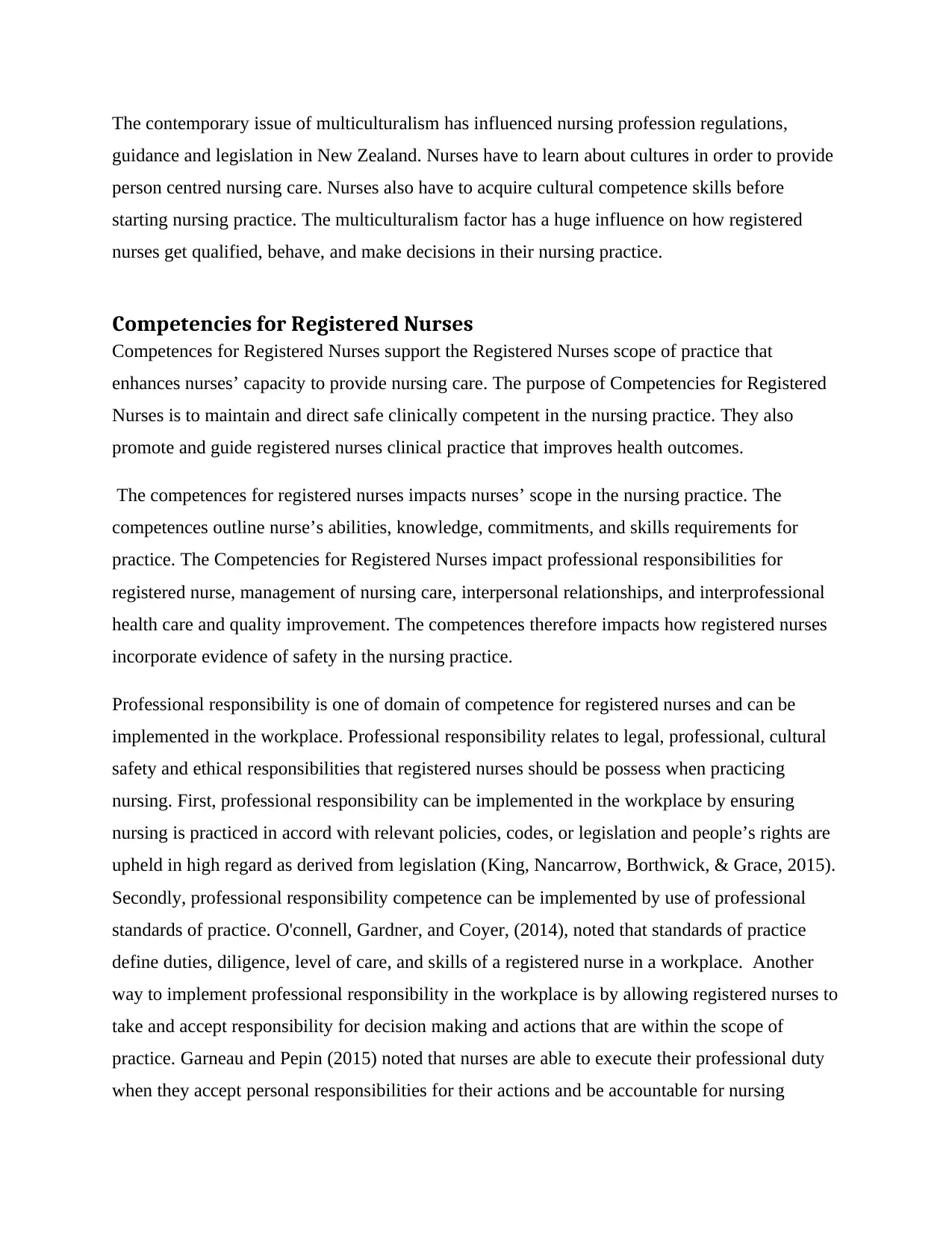
The contemporary issue of multiculturalism has influenced nursing profession regulations,
guidance and legislation in New Zealand. Nurses have to learn about cultures in order to provide
person centred nursing care. Nurses also have to acquire cultural competence skills before
starting nursing practice. The multiculturalism factor has a huge influence on how registered
nurses get qualified, behave, and make decisions in their nursing practice.
Competencies for Registered Nurses
Competences for Registered Nurses support the Registered Nurses scope of practice that
enhances nurses’ capacity to provide nursing care. The purpose of Competencies for Registered
Nurses is to maintain and direct safe clinically competent in the nursing practice. They also
promote and guide registered nurses clinical practice that improves health outcomes.
The competences for registered nurses impacts nurses’ scope in the nursing practice. The
competences outline nurse’s abilities, knowledge, commitments, and skills requirements for
practice. The Competencies for Registered Nurses impact professional responsibilities for
registered nurse, management of nursing care, interpersonal relationships, and interprofessional
health care and quality improvement. The competences therefore impacts how registered nurses
incorporate evidence of safety in the nursing practice.
Professional responsibility is one of domain of competence for registered nurses and can be
implemented in the workplace. Professional responsibility relates to legal, professional, cultural
safety and ethical responsibilities that registered nurses should be possess when practicing
nursing. First, professional responsibility can be implemented in the workplace by ensuring
nursing is practiced in accord with relevant policies, codes, or legislation and people’s rights are
upheld in high regard as derived from legislation (King, Nancarrow, Borthwick, & Grace, 2015).
Secondly, professional responsibility competence can be implemented by use of professional
standards of practice. O'connell, Gardner, and Coyer, (2014), noted that standards of practice
define duties, diligence, level of care, and skills of a registered nurse in a workplace. Another
way to implement professional responsibility in the workplace is by allowing registered nurses to
take and accept responsibility for decision making and actions that are within the scope of
practice. Garneau and Pepin (2015) noted that nurses are able to execute their professional duty
when they accept personal responsibilities for their actions and be accountable for nursing
guidance and legislation in New Zealand. Nurses have to learn about cultures in order to provide
person centred nursing care. Nurses also have to acquire cultural competence skills before
starting nursing practice. The multiculturalism factor has a huge influence on how registered
nurses get qualified, behave, and make decisions in their nursing practice.
Competencies for Registered Nurses
Competences for Registered Nurses support the Registered Nurses scope of practice that
enhances nurses’ capacity to provide nursing care. The purpose of Competencies for Registered
Nurses is to maintain and direct safe clinically competent in the nursing practice. They also
promote and guide registered nurses clinical practice that improves health outcomes.
The competences for registered nurses impacts nurses’ scope in the nursing practice. The
competences outline nurse’s abilities, knowledge, commitments, and skills requirements for
practice. The Competencies for Registered Nurses impact professional responsibilities for
registered nurse, management of nursing care, interpersonal relationships, and interprofessional
health care and quality improvement. The competences therefore impacts how registered nurses
incorporate evidence of safety in the nursing practice.
Professional responsibility is one of domain of competence for registered nurses and can be
implemented in the workplace. Professional responsibility relates to legal, professional, cultural
safety and ethical responsibilities that registered nurses should be possess when practicing
nursing. First, professional responsibility can be implemented in the workplace by ensuring
nursing is practiced in accord with relevant policies, codes, or legislation and people’s rights are
upheld in high regard as derived from legislation (King, Nancarrow, Borthwick, & Grace, 2015).
Secondly, professional responsibility competence can be implemented by use of professional
standards of practice. O'connell, Gardner, and Coyer, (2014), noted that standards of practice
define duties, diligence, level of care, and skills of a registered nurse in a workplace. Another
way to implement professional responsibility in the workplace is by allowing registered nurses to
take and accept responsibility for decision making and actions that are within the scope of
practice. Garneau and Pepin (2015) noted that nurses are able to execute their professional duty
when they accept personal responsibilities for their actions and be accountable for nursing
Paraphrase This Document
Need a fresh take? Get an instant paraphrase of this document with our AI Paraphraser
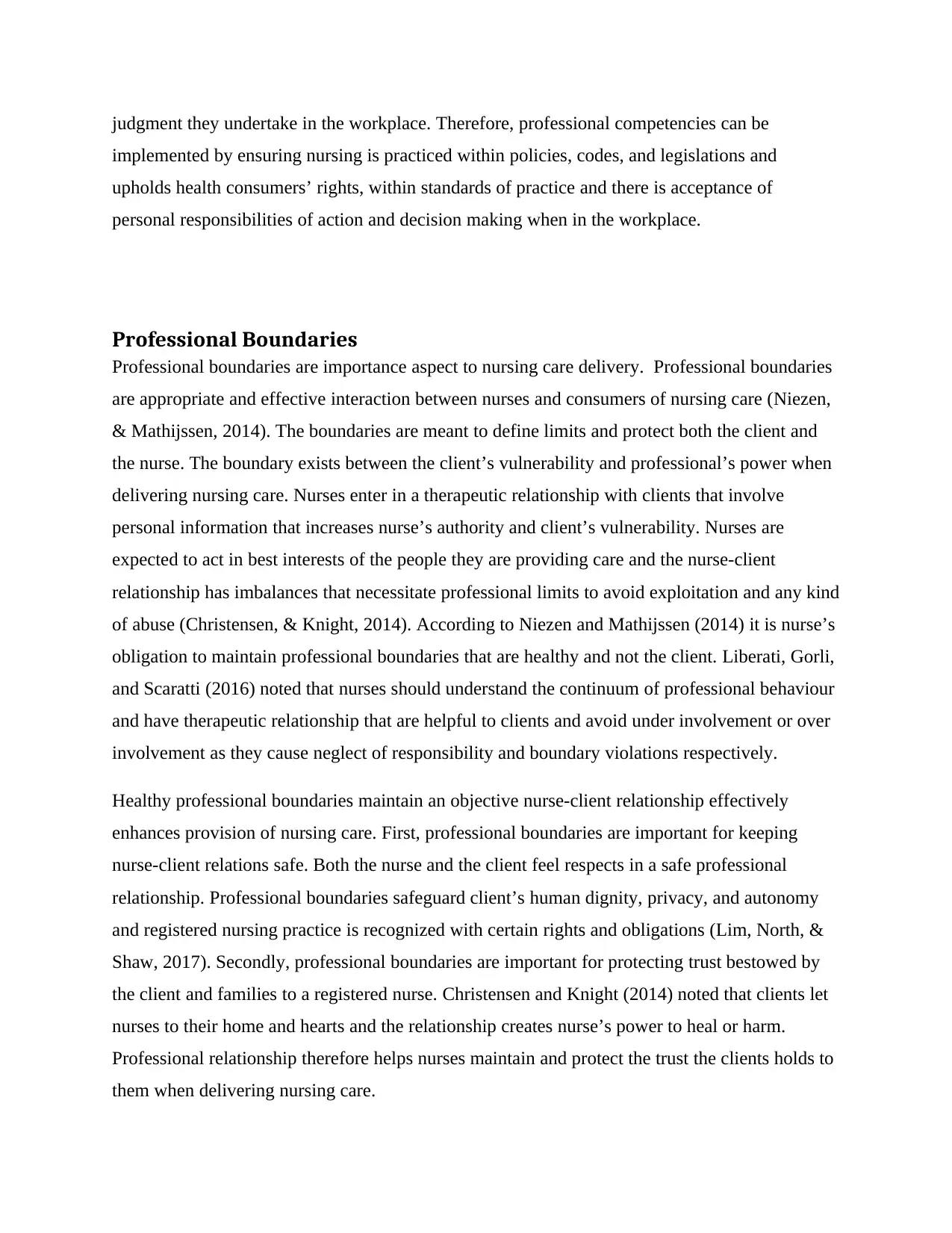
judgment they undertake in the workplace. Therefore, professional competencies can be
implemented by ensuring nursing is practiced within policies, codes, and legislations and
upholds health consumers’ rights, within standards of practice and there is acceptance of
personal responsibilities of action and decision making when in the workplace.
Professional Boundaries
Professional boundaries are importance aspect to nursing care delivery. Professional boundaries
are appropriate and effective interaction between nurses and consumers of nursing care (Niezen,
& Mathijssen, 2014). The boundaries are meant to define limits and protect both the client and
the nurse. The boundary exists between the client’s vulnerability and professional’s power when
delivering nursing care. Nurses enter in a therapeutic relationship with clients that involve
personal information that increases nurse’s authority and client’s vulnerability. Nurses are
expected to act in best interests of the people they are providing care and the nurse-client
relationship has imbalances that necessitate professional limits to avoid exploitation and any kind
of abuse (Christensen, & Knight, 2014). According to Niezen and Mathijssen (2014) it is nurse’s
obligation to maintain professional boundaries that are healthy and not the client. Liberati, Gorli,
and Scaratti (2016) noted that nurses should understand the continuum of professional behaviour
and have therapeutic relationship that are helpful to clients and avoid under involvement or over
involvement as they cause neglect of responsibility and boundary violations respectively.
Healthy professional boundaries maintain an objective nurse-client relationship effectively
enhances provision of nursing care. First, professional boundaries are important for keeping
nurse-client relations safe. Both the nurse and the client feel respects in a safe professional
relationship. Professional boundaries safeguard client’s human dignity, privacy, and autonomy
and registered nursing practice is recognized with certain rights and obligations (Lim, North, &
Shaw, 2017). Secondly, professional boundaries are important for protecting trust bestowed by
the client and families to a registered nurse. Christensen and Knight (2014) noted that clients let
nurses to their home and hearts and the relationship creates nurse’s power to heal or harm.
Professional relationship therefore helps nurses maintain and protect the trust the clients holds to
them when delivering nursing care.
implemented by ensuring nursing is practiced within policies, codes, and legislations and
upholds health consumers’ rights, within standards of practice and there is acceptance of
personal responsibilities of action and decision making when in the workplace.
Professional Boundaries
Professional boundaries are importance aspect to nursing care delivery. Professional boundaries
are appropriate and effective interaction between nurses and consumers of nursing care (Niezen,
& Mathijssen, 2014). The boundaries are meant to define limits and protect both the client and
the nurse. The boundary exists between the client’s vulnerability and professional’s power when
delivering nursing care. Nurses enter in a therapeutic relationship with clients that involve
personal information that increases nurse’s authority and client’s vulnerability. Nurses are
expected to act in best interests of the people they are providing care and the nurse-client
relationship has imbalances that necessitate professional limits to avoid exploitation and any kind
of abuse (Christensen, & Knight, 2014). According to Niezen and Mathijssen (2014) it is nurse’s
obligation to maintain professional boundaries that are healthy and not the client. Liberati, Gorli,
and Scaratti (2016) noted that nurses should understand the continuum of professional behaviour
and have therapeutic relationship that are helpful to clients and avoid under involvement or over
involvement as they cause neglect of responsibility and boundary violations respectively.
Healthy professional boundaries maintain an objective nurse-client relationship effectively
enhances provision of nursing care. First, professional boundaries are important for keeping
nurse-client relations safe. Both the nurse and the client feel respects in a safe professional
relationship. Professional boundaries safeguard client’s human dignity, privacy, and autonomy
and registered nursing practice is recognized with certain rights and obligations (Lim, North, &
Shaw, 2017). Secondly, professional boundaries are important for protecting trust bestowed by
the client and families to a registered nurse. Christensen and Knight (2014) noted that clients let
nurses to their home and hearts and the relationship creates nurse’s power to heal or harm.
Professional relationship therefore helps nurses maintain and protect the trust the clients holds to
them when delivering nursing care.
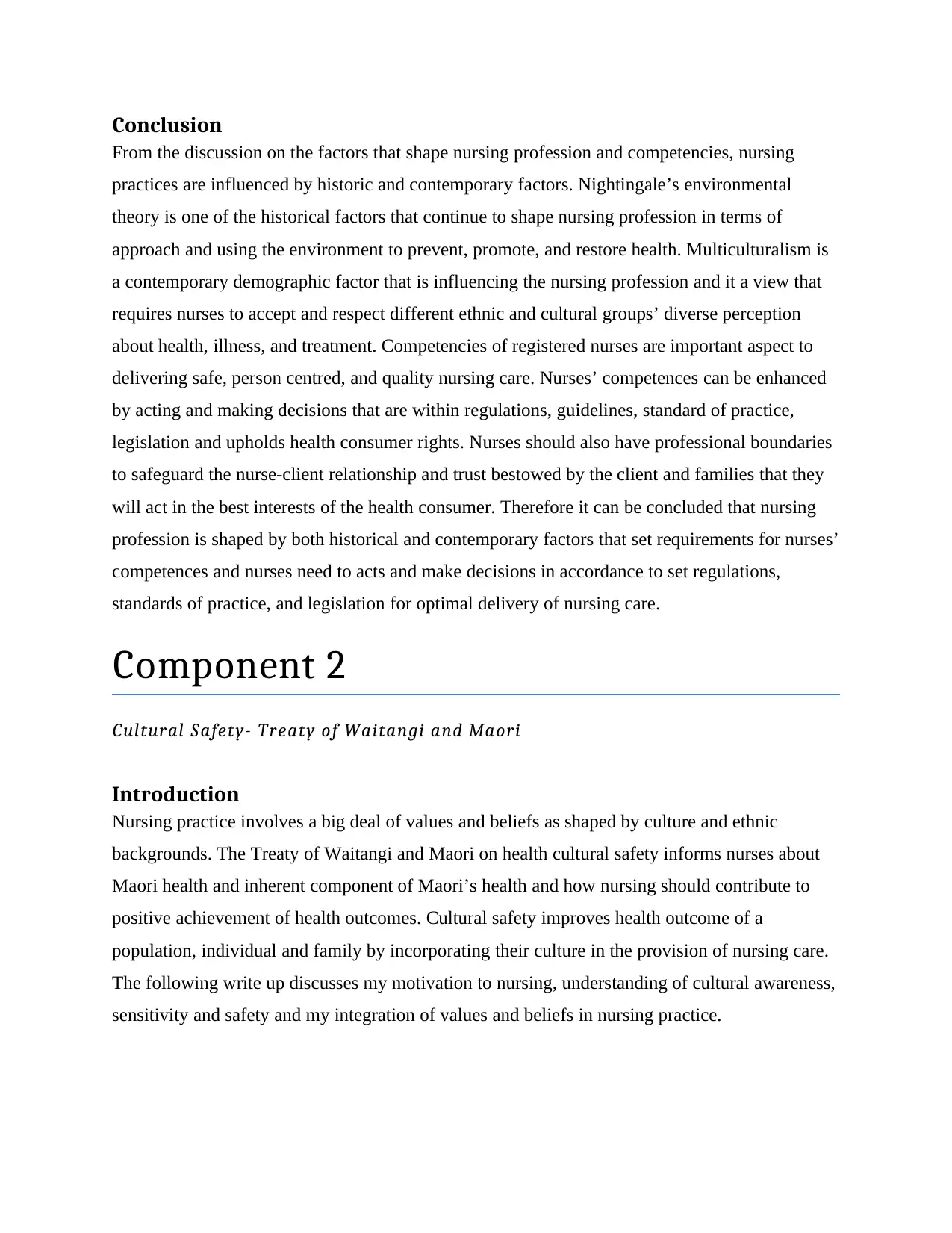
Conclusion
From the discussion on the factors that shape nursing profession and competencies, nursing
practices are influenced by historic and contemporary factors. Nightingale’s environmental
theory is one of the historical factors that continue to shape nursing profession in terms of
approach and using the environment to prevent, promote, and restore health. Multiculturalism is
a contemporary demographic factor that is influencing the nursing profession and it a view that
requires nurses to accept and respect different ethnic and cultural groups’ diverse perception
about health, illness, and treatment. Competencies of registered nurses are important aspect to
delivering safe, person centred, and quality nursing care. Nurses’ competences can be enhanced
by acting and making decisions that are within regulations, guidelines, standard of practice,
legislation and upholds health consumer rights. Nurses should also have professional boundaries
to safeguard the nurse-client relationship and trust bestowed by the client and families that they
will act in the best interests of the health consumer. Therefore it can be concluded that nursing
profession is shaped by both historical and contemporary factors that set requirements for nurses’
competences and nurses need to acts and make decisions in accordance to set regulations,
standards of practice, and legislation for optimal delivery of nursing care.
Component 2
Cultural Safety- Treaty of Waitangi and Maori
Introduction
Nursing practice involves a big deal of values and beliefs as shaped by culture and ethnic
backgrounds. The Treaty of Waitangi and Maori on health cultural safety informs nurses about
Maori health and inherent component of Maori’s health and how nursing should contribute to
positive achievement of health outcomes. Cultural safety improves health outcome of a
population, individual and family by incorporating their culture in the provision of nursing care.
The following write up discusses my motivation to nursing, understanding of cultural awareness,
sensitivity and safety and my integration of values and beliefs in nursing practice.
From the discussion on the factors that shape nursing profession and competencies, nursing
practices are influenced by historic and contemporary factors. Nightingale’s environmental
theory is one of the historical factors that continue to shape nursing profession in terms of
approach and using the environment to prevent, promote, and restore health. Multiculturalism is
a contemporary demographic factor that is influencing the nursing profession and it a view that
requires nurses to accept and respect different ethnic and cultural groups’ diverse perception
about health, illness, and treatment. Competencies of registered nurses are important aspect to
delivering safe, person centred, and quality nursing care. Nurses’ competences can be enhanced
by acting and making decisions that are within regulations, guidelines, standard of practice,
legislation and upholds health consumer rights. Nurses should also have professional boundaries
to safeguard the nurse-client relationship and trust bestowed by the client and families that they
will act in the best interests of the health consumer. Therefore it can be concluded that nursing
profession is shaped by both historical and contemporary factors that set requirements for nurses’
competences and nurses need to acts and make decisions in accordance to set regulations,
standards of practice, and legislation for optimal delivery of nursing care.
Component 2
Cultural Safety- Treaty of Waitangi and Maori
Introduction
Nursing practice involves a big deal of values and beliefs as shaped by culture and ethnic
backgrounds. The Treaty of Waitangi and Maori on health cultural safety informs nurses about
Maori health and inherent component of Maori’s health and how nursing should contribute to
positive achievement of health outcomes. Cultural safety improves health outcome of a
population, individual and family by incorporating their culture in the provision of nursing care.
The following write up discusses my motivation to nursing, understanding of cultural awareness,
sensitivity and safety and my integration of values and beliefs in nursing practice.
⊘ This is a preview!⊘
Do you want full access?
Subscribe today to unlock all pages.

Trusted by 1+ million students worldwide
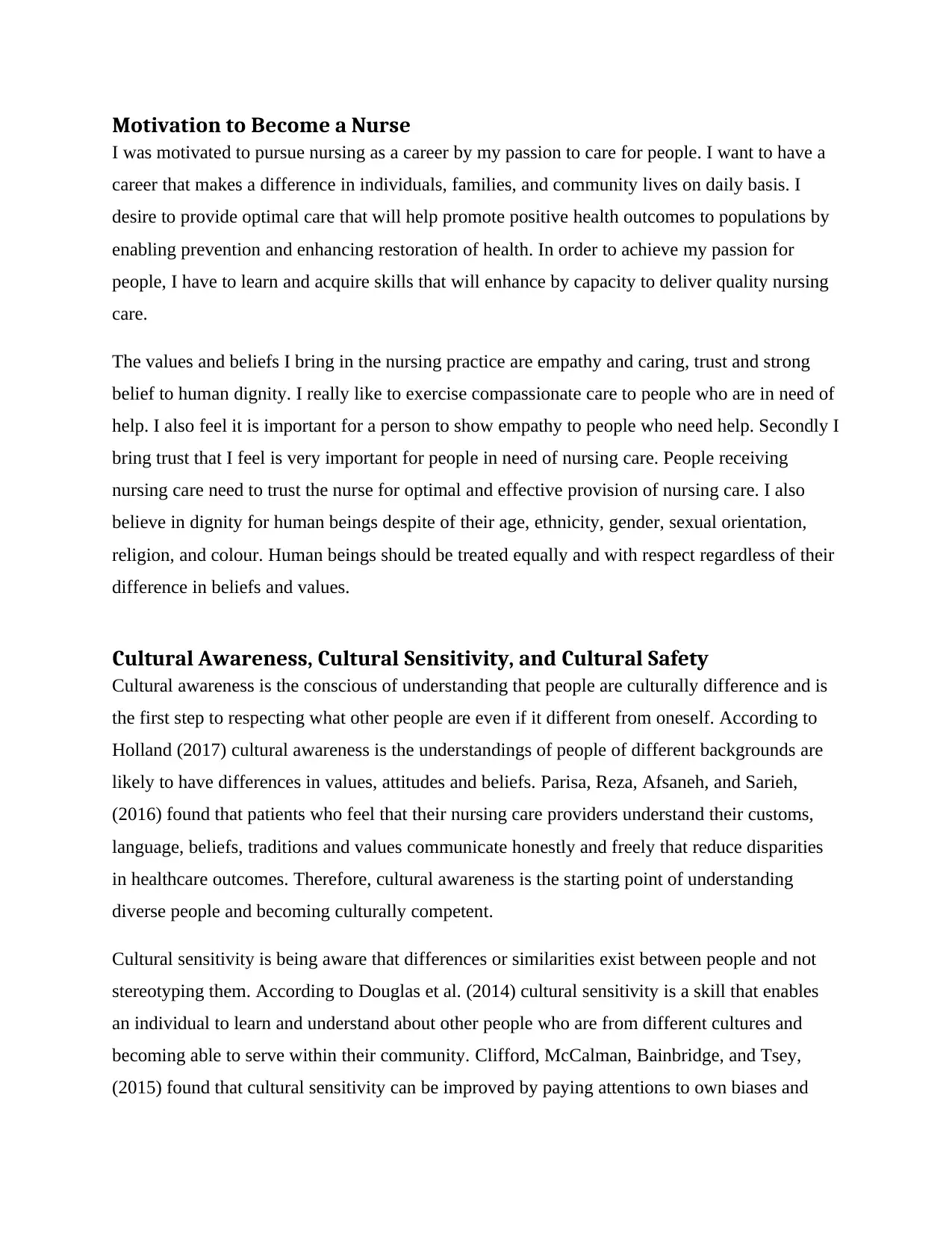
Motivation to Become a Nurse
I was motivated to pursue nursing as a career by my passion to care for people. I want to have a
career that makes a difference in individuals, families, and community lives on daily basis. I
desire to provide optimal care that will help promote positive health outcomes to populations by
enabling prevention and enhancing restoration of health. In order to achieve my passion for
people, I have to learn and acquire skills that will enhance by capacity to deliver quality nursing
care.
The values and beliefs I bring in the nursing practice are empathy and caring, trust and strong
belief to human dignity. I really like to exercise compassionate care to people who are in need of
help. I also feel it is important for a person to show empathy to people who need help. Secondly I
bring trust that I feel is very important for people in need of nursing care. People receiving
nursing care need to trust the nurse for optimal and effective provision of nursing care. I also
believe in dignity for human beings despite of their age, ethnicity, gender, sexual orientation,
religion, and colour. Human beings should be treated equally and with respect regardless of their
difference in beliefs and values.
Cultural Awareness, Cultural Sensitivity, and Cultural Safety
Cultural awareness is the conscious of understanding that people are culturally difference and is
the first step to respecting what other people are even if it different from oneself. According to
Holland (2017) cultural awareness is the understandings of people of different backgrounds are
likely to have differences in values, attitudes and beliefs. Parisa, Reza, Afsaneh, and Sarieh,
(2016) found that patients who feel that their nursing care providers understand their customs,
language, beliefs, traditions and values communicate honestly and freely that reduce disparities
in healthcare outcomes. Therefore, cultural awareness is the starting point of understanding
diverse people and becoming culturally competent.
Cultural sensitivity is being aware that differences or similarities exist between people and not
stereotyping them. According to Douglas et al. (2014) cultural sensitivity is a skill that enables
an individual to learn and understand about other people who are from different cultures and
becoming able to serve within their community. Clifford, McCalman, Bainbridge, and Tsey,
(2015) found that cultural sensitivity can be improved by paying attentions to own biases and
I was motivated to pursue nursing as a career by my passion to care for people. I want to have a
career that makes a difference in individuals, families, and community lives on daily basis. I
desire to provide optimal care that will help promote positive health outcomes to populations by
enabling prevention and enhancing restoration of health. In order to achieve my passion for
people, I have to learn and acquire skills that will enhance by capacity to deliver quality nursing
care.
The values and beliefs I bring in the nursing practice are empathy and caring, trust and strong
belief to human dignity. I really like to exercise compassionate care to people who are in need of
help. I also feel it is important for a person to show empathy to people who need help. Secondly I
bring trust that I feel is very important for people in need of nursing care. People receiving
nursing care need to trust the nurse for optimal and effective provision of nursing care. I also
believe in dignity for human beings despite of their age, ethnicity, gender, sexual orientation,
religion, and colour. Human beings should be treated equally and with respect regardless of their
difference in beliefs and values.
Cultural Awareness, Cultural Sensitivity, and Cultural Safety
Cultural awareness is the conscious of understanding that people are culturally difference and is
the first step to respecting what other people are even if it different from oneself. According to
Holland (2017) cultural awareness is the understandings of people of different backgrounds are
likely to have differences in values, attitudes and beliefs. Parisa, Reza, Afsaneh, and Sarieh,
(2016) found that patients who feel that their nursing care providers understand their customs,
language, beliefs, traditions and values communicate honestly and freely that reduce disparities
in healthcare outcomes. Therefore, cultural awareness is the starting point of understanding
diverse people and becoming culturally competent.
Cultural sensitivity is being aware that differences or similarities exist between people and not
stereotyping them. According to Douglas et al. (2014) cultural sensitivity is a skill that enables
an individual to learn and understand about other people who are from different cultures and
becoming able to serve within their community. Clifford, McCalman, Bainbridge, and Tsey,
(2015) found that cultural sensitivity can be improved by paying attentions to own biases and
Paraphrase This Document
Need a fresh take? Get an instant paraphrase of this document with our AI Paraphraser
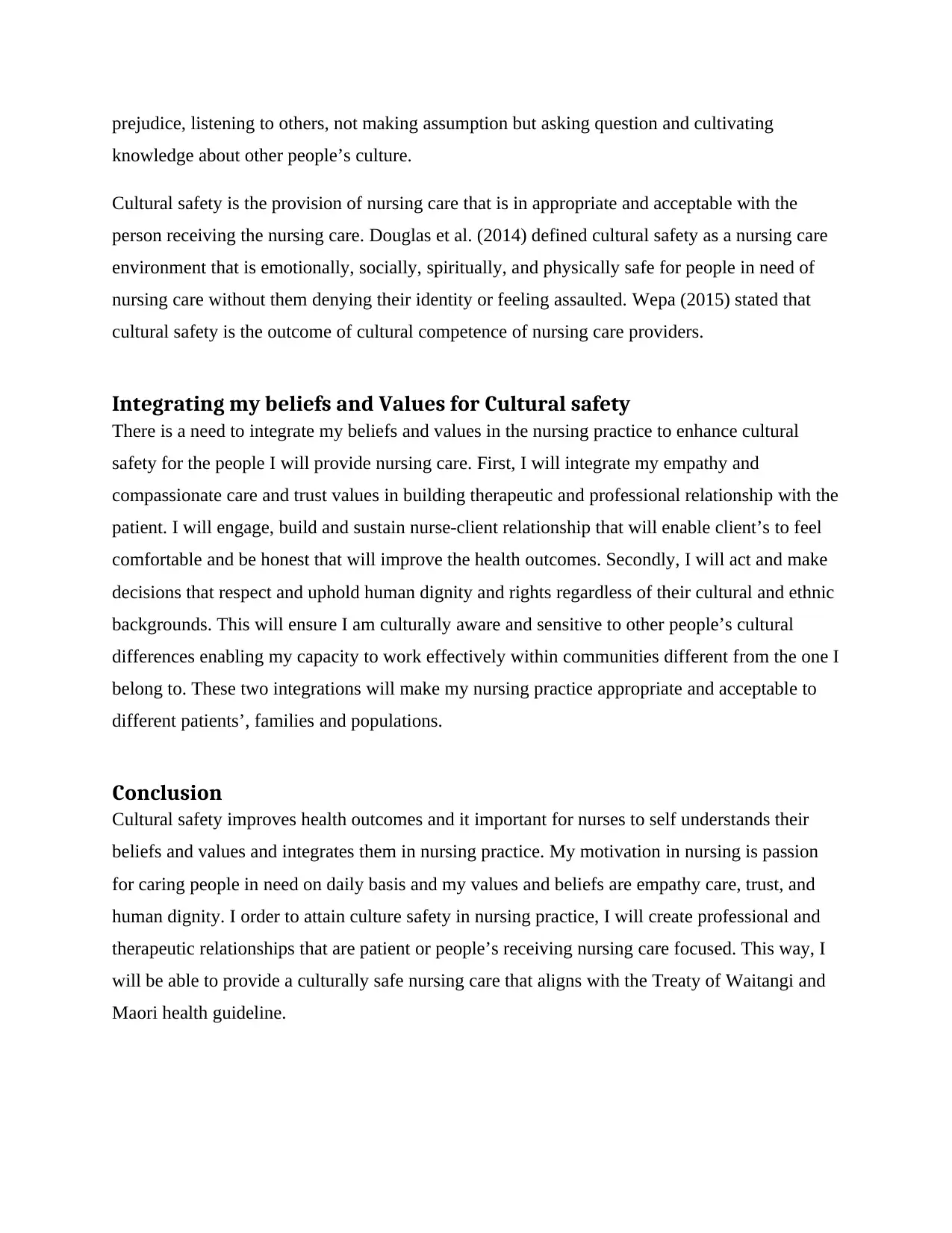
prejudice, listening to others, not making assumption but asking question and cultivating
knowledge about other people’s culture.
Cultural safety is the provision of nursing care that is in appropriate and acceptable with the
person receiving the nursing care. Douglas et al. (2014) defined cultural safety as a nursing care
environment that is emotionally, socially, spiritually, and physically safe for people in need of
nursing care without them denying their identity or feeling assaulted. Wepa (2015) stated that
cultural safety is the outcome of cultural competence of nursing care providers.
Integrating my beliefs and Values for Cultural safety
There is a need to integrate my beliefs and values in the nursing practice to enhance cultural
safety for the people I will provide nursing care. First, I will integrate my empathy and
compassionate care and trust values in building therapeutic and professional relationship with the
patient. I will engage, build and sustain nurse-client relationship that will enable client’s to feel
comfortable and be honest that will improve the health outcomes. Secondly, I will act and make
decisions that respect and uphold human dignity and rights regardless of their cultural and ethnic
backgrounds. This will ensure I am culturally aware and sensitive to other people’s cultural
differences enabling my capacity to work effectively within communities different from the one I
belong to. These two integrations will make my nursing practice appropriate and acceptable to
different patients’, families and populations.
Conclusion
Cultural safety improves health outcomes and it important for nurses to self understands their
beliefs and values and integrates them in nursing practice. My motivation in nursing is passion
for caring people in need on daily basis and my values and beliefs are empathy care, trust, and
human dignity. I order to attain culture safety in nursing practice, I will create professional and
therapeutic relationships that are patient or people’s receiving nursing care focused. This way, I
will be able to provide a culturally safe nursing care that aligns with the Treaty of Waitangi and
Maori health guideline.
knowledge about other people’s culture.
Cultural safety is the provision of nursing care that is in appropriate and acceptable with the
person receiving the nursing care. Douglas et al. (2014) defined cultural safety as a nursing care
environment that is emotionally, socially, spiritually, and physically safe for people in need of
nursing care without them denying their identity or feeling assaulted. Wepa (2015) stated that
cultural safety is the outcome of cultural competence of nursing care providers.
Integrating my beliefs and Values for Cultural safety
There is a need to integrate my beliefs and values in the nursing practice to enhance cultural
safety for the people I will provide nursing care. First, I will integrate my empathy and
compassionate care and trust values in building therapeutic and professional relationship with the
patient. I will engage, build and sustain nurse-client relationship that will enable client’s to feel
comfortable and be honest that will improve the health outcomes. Secondly, I will act and make
decisions that respect and uphold human dignity and rights regardless of their cultural and ethnic
backgrounds. This will ensure I am culturally aware and sensitive to other people’s cultural
differences enabling my capacity to work effectively within communities different from the one I
belong to. These two integrations will make my nursing practice appropriate and acceptable to
different patients’, families and populations.
Conclusion
Cultural safety improves health outcomes and it important for nurses to self understands their
beliefs and values and integrates them in nursing practice. My motivation in nursing is passion
for caring people in need on daily basis and my values and beliefs are empathy care, trust, and
human dignity. I order to attain culture safety in nursing practice, I will create professional and
therapeutic relationships that are patient or people’s receiving nursing care focused. This way, I
will be able to provide a culturally safe nursing care that aligns with the Treaty of Waitangi and
Maori health guideline.
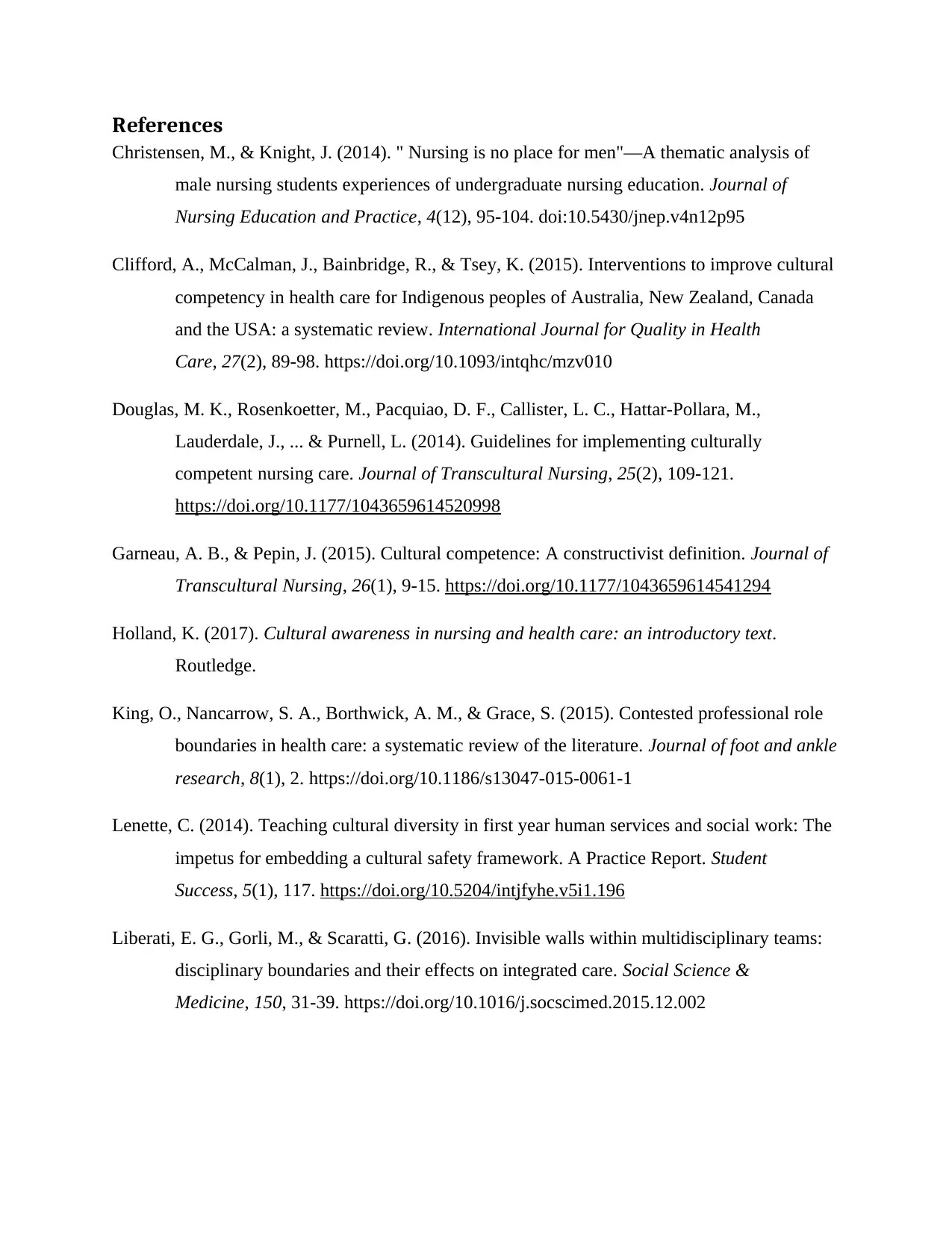
References
Christensen, M., & Knight, J. (2014). " Nursing is no place for men"―A thematic analysis of
male nursing students experiences of undergraduate nursing education. Journal of
Nursing Education and Practice, 4(12), 95-104. doi:10.5430/jnep.v4n12p95
Clifford, A., McCalman, J., Bainbridge, R., & Tsey, K. (2015). Interventions to improve cultural
competency in health care for Indigenous peoples of Australia, New Zealand, Canada
and the USA: a systematic review. International Journal for Quality in Health
Care, 27(2), 89-98. https://doi.org/10.1093/intqhc/mzv010
Douglas, M. K., Rosenkoetter, M., Pacquiao, D. F., Callister, L. C., Hattar-Pollara, M.,
Lauderdale, J., ... & Purnell, L. (2014). Guidelines for implementing culturally
competent nursing care. Journal of Transcultural Nursing, 25(2), 109-121.
https://doi.org/10.1177/1043659614520998
Garneau, A. B., & Pepin, J. (2015). Cultural competence: A constructivist definition. Journal of
Transcultural Nursing, 26(1), 9-15. https://doi.org/10.1177/1043659614541294
Holland, K. (2017). Cultural awareness in nursing and health care: an introductory text.
Routledge.
King, O., Nancarrow, S. A., Borthwick, A. M., & Grace, S. (2015). Contested professional role
boundaries in health care: a systematic review of the literature. Journal of foot and ankle
research, 8(1), 2. https://doi.org/10.1186/s13047-015-0061-1
Lenette, C. (2014). Teaching cultural diversity in first year human services and social work: The
impetus for embedding a cultural safety framework. A Practice Report. Student
Success, 5(1), 117. https://doi.org/10.5204/intjfyhe.v5i1.196
Liberati, E. G., Gorli, M., & Scaratti, G. (2016). Invisible walls within multidisciplinary teams:
disciplinary boundaries and their effects on integrated care. Social Science &
Medicine, 150, 31-39. https://doi.org/10.1016/j.socscimed.2015.12.002
Christensen, M., & Knight, J. (2014). " Nursing is no place for men"―A thematic analysis of
male nursing students experiences of undergraduate nursing education. Journal of
Nursing Education and Practice, 4(12), 95-104. doi:10.5430/jnep.v4n12p95
Clifford, A., McCalman, J., Bainbridge, R., & Tsey, K. (2015). Interventions to improve cultural
competency in health care for Indigenous peoples of Australia, New Zealand, Canada
and the USA: a systematic review. International Journal for Quality in Health
Care, 27(2), 89-98. https://doi.org/10.1093/intqhc/mzv010
Douglas, M. K., Rosenkoetter, M., Pacquiao, D. F., Callister, L. C., Hattar-Pollara, M.,
Lauderdale, J., ... & Purnell, L. (2014). Guidelines for implementing culturally
competent nursing care. Journal of Transcultural Nursing, 25(2), 109-121.
https://doi.org/10.1177/1043659614520998
Garneau, A. B., & Pepin, J. (2015). Cultural competence: A constructivist definition. Journal of
Transcultural Nursing, 26(1), 9-15. https://doi.org/10.1177/1043659614541294
Holland, K. (2017). Cultural awareness in nursing and health care: an introductory text.
Routledge.
King, O., Nancarrow, S. A., Borthwick, A. M., & Grace, S. (2015). Contested professional role
boundaries in health care: a systematic review of the literature. Journal of foot and ankle
research, 8(1), 2. https://doi.org/10.1186/s13047-015-0061-1
Lenette, C. (2014). Teaching cultural diversity in first year human services and social work: The
impetus for embedding a cultural safety framework. A Practice Report. Student
Success, 5(1), 117. https://doi.org/10.5204/intjfyhe.v5i1.196
Liberati, E. G., Gorli, M., & Scaratti, G. (2016). Invisible walls within multidisciplinary teams:
disciplinary boundaries and their effects on integrated care. Social Science &
Medicine, 150, 31-39. https://doi.org/10.1016/j.socscimed.2015.12.002
⊘ This is a preview!⊘
Do you want full access?
Subscribe today to unlock all pages.

Trusted by 1+ million students worldwide
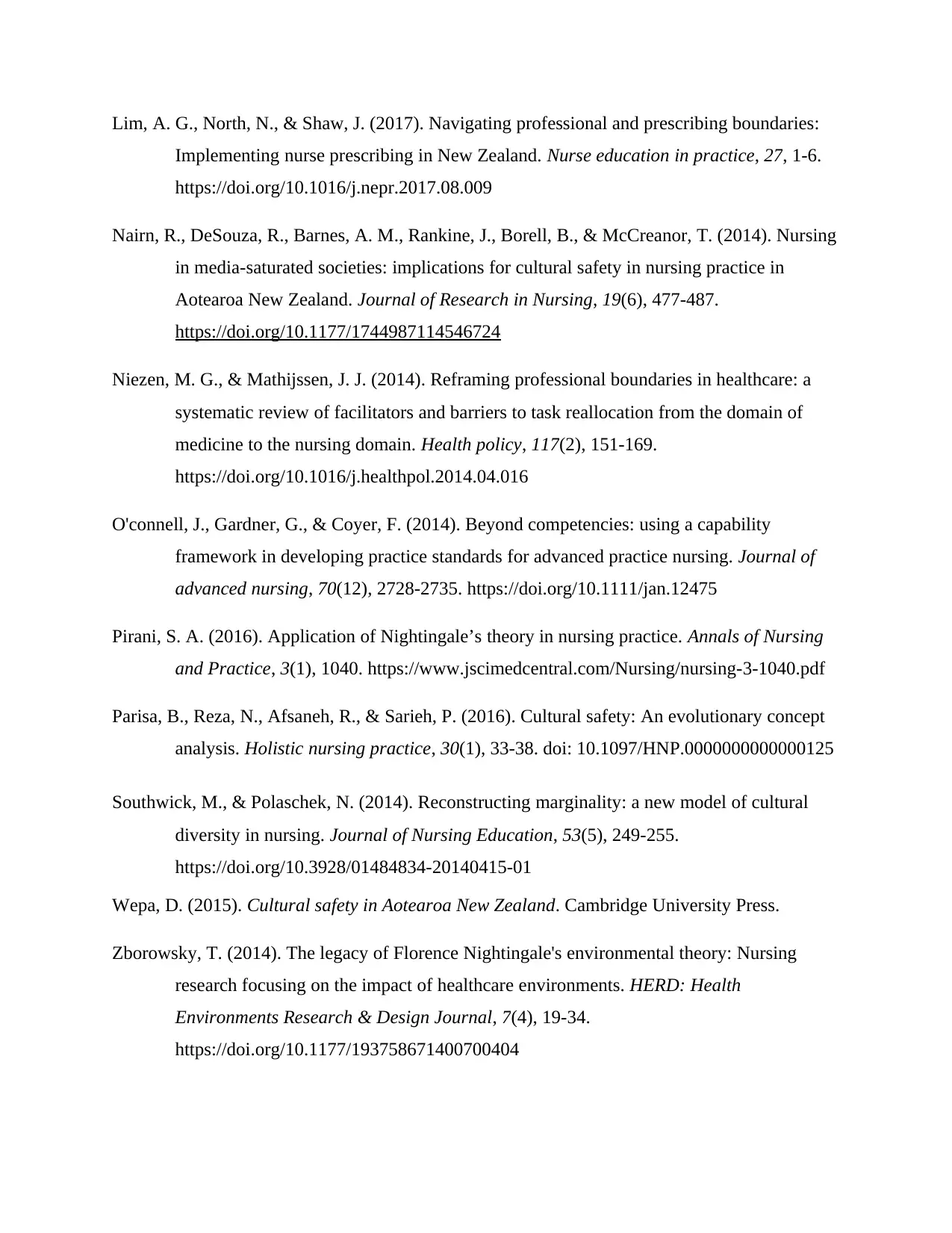
Lim, A. G., North, N., & Shaw, J. (2017). Navigating professional and prescribing boundaries:
Implementing nurse prescribing in New Zealand. Nurse education in practice, 27, 1-6.
https://doi.org/10.1016/j.nepr.2017.08.009
Nairn, R., DeSouza, R., Barnes, A. M., Rankine, J., Borell, B., & McCreanor, T. (2014). Nursing
in media-saturated societies: implications for cultural safety in nursing practice in
Aotearoa New Zealand. Journal of Research in Nursing, 19(6), 477-487.
https://doi.org/10.1177/1744987114546724
Niezen, M. G., & Mathijssen, J. J. (2014). Reframing professional boundaries in healthcare: a
systematic review of facilitators and barriers to task reallocation from the domain of
medicine to the nursing domain. Health policy, 117(2), 151-169.
https://doi.org/10.1016/j.healthpol.2014.04.016
O'connell, J., Gardner, G., & Coyer, F. (2014). Beyond competencies: using a capability
framework in developing practice standards for advanced practice nursing. Journal of
advanced nursing, 70(12), 2728-2735. https://doi.org/10.1111/jan.12475
Pirani, S. A. (2016). Application of Nightingale’s theory in nursing practice. Annals of Nursing
and Practice, 3(1), 1040. https://www.jscimedcentral.com/Nursing/nursing-3-1040.pdf
Parisa, B., Reza, N., Afsaneh, R., & Sarieh, P. (2016). Cultural safety: An evolutionary concept
analysis. Holistic nursing practice, 30(1), 33-38. doi: 10.1097/HNP.0000000000000125
Southwick, M., & Polaschek, N. (2014). Reconstructing marginality: a new model of cultural
diversity in nursing. Journal of Nursing Education, 53(5), 249-255.
https://doi.org/10.3928/01484834-20140415-01
Wepa, D. (2015). Cultural safety in Aotearoa New Zealand. Cambridge University Press.
Zborowsky, T. (2014). The legacy of Florence Nightingale's environmental theory: Nursing
research focusing on the impact of healthcare environments. HERD: Health
Environments Research & Design Journal, 7(4), 19-34.
https://doi.org/10.1177/193758671400700404
Implementing nurse prescribing in New Zealand. Nurse education in practice, 27, 1-6.
https://doi.org/10.1016/j.nepr.2017.08.009
Nairn, R., DeSouza, R., Barnes, A. M., Rankine, J., Borell, B., & McCreanor, T. (2014). Nursing
in media-saturated societies: implications for cultural safety in nursing practice in
Aotearoa New Zealand. Journal of Research in Nursing, 19(6), 477-487.
https://doi.org/10.1177/1744987114546724
Niezen, M. G., & Mathijssen, J. J. (2014). Reframing professional boundaries in healthcare: a
systematic review of facilitators and barriers to task reallocation from the domain of
medicine to the nursing domain. Health policy, 117(2), 151-169.
https://doi.org/10.1016/j.healthpol.2014.04.016
O'connell, J., Gardner, G., & Coyer, F. (2014). Beyond competencies: using a capability
framework in developing practice standards for advanced practice nursing. Journal of
advanced nursing, 70(12), 2728-2735. https://doi.org/10.1111/jan.12475
Pirani, S. A. (2016). Application of Nightingale’s theory in nursing practice. Annals of Nursing
and Practice, 3(1), 1040. https://www.jscimedcentral.com/Nursing/nursing-3-1040.pdf
Parisa, B., Reza, N., Afsaneh, R., & Sarieh, P. (2016). Cultural safety: An evolutionary concept
analysis. Holistic nursing practice, 30(1), 33-38. doi: 10.1097/HNP.0000000000000125
Southwick, M., & Polaschek, N. (2014). Reconstructing marginality: a new model of cultural
diversity in nursing. Journal of Nursing Education, 53(5), 249-255.
https://doi.org/10.3928/01484834-20140415-01
Wepa, D. (2015). Cultural safety in Aotearoa New Zealand. Cambridge University Press.
Zborowsky, T. (2014). The legacy of Florence Nightingale's environmental theory: Nursing
research focusing on the impact of healthcare environments. HERD: Health
Environments Research & Design Journal, 7(4), 19-34.
https://doi.org/10.1177/193758671400700404
Paraphrase This Document
Need a fresh take? Get an instant paraphrase of this document with our AI Paraphraser

1 out of 11
Related Documents
Your All-in-One AI-Powered Toolkit for Academic Success.
+13062052269
info@desklib.com
Available 24*7 on WhatsApp / Email
![[object Object]](/_next/static/media/star-bottom.7253800d.svg)
Unlock your academic potential
Copyright © 2020–2025 A2Z Services. All Rights Reserved. Developed and managed by ZUCOL.





